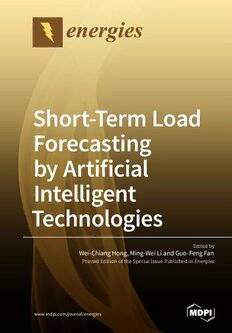Table Of ContentShort-Term Load
Forecasting
by Artificial
Intelligent
Technologies
Edited by
Wei-Chiang Hong, Ming-Wei Li and Guo-Feng Fan
Printed Edition of the Special Issue Published in Energies
www.mdpi.com/journal/energies
Short-Term Load Forecasting by
Artificial Intelligent Technologies
Short-Term Load Forecasting by
Artificial Intelligent Technologies
SpecialIssueEditors
Wei-ChiangHong
Ming-WeiLi
Guo-FengFan
MDPI•Basel•Beijing•Wuhan•Barcelona•Belgrade
SpecialIssueEditors
Wei-ChiangHong Ming-WeiLi Guo-FengFan
JiangsuNormalUniversity HarbinEngineeringUniversity PingdingshanUniversity
China China China
EditorialOffice
MDPI
St.Alban-Anlage66
4052Basel,Switzerland
ThisisareprintofarticlesfromtheSpecialIssuepublishedonlineintheopenaccessjournalEnergies
(ISSN1996-1073)from2018to2019(availableat:https://www.mdpi.com/journal/energies/special
issues/ShortTermLoadForecasting)
Forcitationpurposes,citeeacharticleindependentlyasindicatedonthearticlepageonlineandas
indicatedbelow:
LastName,A.A.; LastName,B.B.; LastName,C.C.ArticleTitle. JournalNameYear,ArticleNumber,
PageRange.
ISBN978-3-03897-582-3(Pbk)
ISBN978-3-03897-583-0(PDF)
(cid:2)c 2019bytheauthors. ArticlesinthisbookareOpenAccessanddistributedundertheCreative
Commons Attribution (CC BY) license, which allows users to download, copy and build upon
publishedarticles,aslongastheauthorandpublisherareproperlycredited,whichensuresmaximum
disseminationandawiderimpactofourpublications.
ThebookasawholeisdistributedbyMDPIunderthetermsandconditionsoftheCreativeCommons
licenseCCBY-NC-ND.
Contents
AbouttheSpecialIssueEditors . . . . . . . . . . . . . . . . . . . . . . . . . . . . . . . . . . . . . vii
Prefaceto”Short-TermLoadForecastingbyArtificialIntelligentTechnologies”. . . . . . . . . ix
Ming-WeiLi,JingGeng,Wei-ChiangHongandYangZhang
HybridizingChaoticandQuantumMechanismsandFruitFlyOptimizationAlgorithmwith
LeastSquaresSupportVectorRegressionModelinElectricLoadForecasting
Reprintedfrom:Energies2018,11,2226,doi:10.3390/en11092226 . . . . . . . . . . . . . . . . . . . 1
YongquanDong,ZichenZhangandWei-ChiangHong
AHybridSeasonalMechanismwithaChaoticCuckooSearchAlgorithmwithaSupportVector
RegressionModelforElectricLoadForecasting
Reprintedfrom:Energies2018,11,1009,doi:10.3390/en11041009 . . . . . . . . . . . . . . . . . . . 23
AshfaqAhmad,NadeemJavaid,AbdulMateen,MuhammadAwaisandZahoorAliKhan
Short-TermLoadForecastinginSmartGrids:AnIntelligentModularApproach
Reprintedfrom:Energies2019,12,164,doi:10.3390/en12010164. . . . . . . . . . . . . . . . . . . . 44
SeonHyeogKim,GyulLee,Gu-YoungKwon,Do-InKimandYong-JuneShin
DeepLearningBasedonMulti-DecompositionforShort-TermLoadForecasting
Reprintedfrom:Energies2018,11,3433,doi:10.3390/en11123433 . . . . . . . . . . . . . . . . . . . 65
Fu-ChengWangandKuang-MingLin
Impacts of Load Profiles on the Optimization of Power Management of a Green Building
EmployingFuelCells
Reprintedfrom:Energies2019,12,57,doi:10.3390/en12010057 . . . . . . . . . . . . . . . . . . . . 82
HabeeburRahman,IniyanSelvarasanandJahithaBegumA
Short-TermForecastingofTotalEnergyConsumptionforIndia-ABlackBoxBasedApproach
Reprintedfrom:Energies2018,11,3442,doi:10.3390/en11123442 . . . . . . . . . . . . . . . . . . . 98
JihoonMoon,YongsungKim,MinjaeSonandEenjunHwang
HybridShort-TermLoadForecastingSchemeUsingRandomForestandMultilayerPerceptron
Reprintedfrom:Energies2018,11,3283,doi:10.3390/en11123283 . . . . . . . . . . . . . . . . . . . 119
MiguelLo´pez,CarlosSans,SergioValeroandCarolinaSenabre
EmpiricalComparisonofNeuralNetworkandAuto-RegressiveModelsinShort-TermLoad
Forecasting
Reprintedfrom:Energies2018,11,2080,doi:10.3390/en11082080 . . . . . . . . . . . . . . . . . . . 139
Mar´ıadelCarmenRuiz-Abello´n,AntonioGabaldo´nandAntonioGuillamo´n
LoadForecastingforaCampusUniversityUsingEnsembleMethodsBasedonRegressionTrees
Reprintedfrom:Energies2018,11,2038,doi:10.3390/en11082038 . . . . . . . . . . . . . . . . . . . 158
GregoryD.Merkel,RichardJ.PovinelliandRonaldH.Brown
Short-TermLoadForecastingofNaturalGaswithDeepNeuralNetworkRegression
Reprintedfrom:Energies2018,11,2008,doi:10.3390/en11082008 . . . . . . . . . . . . . . . . . . . 180
Fu-ChengWang,Yi-ShaoHsiaoandYi-ZheYang
TheOptimizationofHybridPowerSystemswithRenewableEnergyandHydrogenGeneration
Reprintedfrom:Energies2018,11,1948,doi:10.3390/en11081948 . . . . . . . . . . . . . . . . . . . 192
v
JingZhao,YaoqiDuanandXiaojuanLiu
Uncertainty Analysis of Weather Forecast Data for Cooling Load Forecasting Based on the
MonteCarloMethod
Reprintedfrom:Energies2018,11,1900,doi:10.3390/en11071900 . . . . . . . . . . . . . . . . . . . 211
BenjaminAuder,JairoCugliari,YannigGoude,Jean-MichelPoggi
ScalableClusteringofIndividualElectricalCurvesforProfilingandBottom-UpForecasting
Reprintedfrom:Energies2018,11,1893,doi:10.3390/en11071893 . . . . . . . . . . . . . . . . . . . 229
MagnusDahl,AdamBrun,OliverS.KirsebomandGormB.Andresen
ImprovingShort-TermHeatLoadForecastswithCalendarandHolidayData
Reprintedfrom:Energies2018,11,1678,doi:10.3390/en11071678 . . . . . . . . . . . . . . . . . . . 251
MerganiA.Khairalla,XuNing,NashatT.AL-JalladandMusaabO.El-Faroug
Short-TermForecastingforEnergyConsumptionthroughStackingHeterogeneousEnsemble
LearningModel
Reprintedfrom:Energies2018,11,1605,doi:10.3390/en11061605 . . . . . . . . . . . . . . . . . . . 267
JiyangWang,YuyangGaoandXuejunChen
A Novel Hybrid Interval Prediction Approach Based on Modified Lower Upper Bound
EstimationinCombinationwithMulti-ObjectiveSalpSwarmAlgorithmforShort-TermLoad
Forecasting
Reprintedfrom:Energies2018,11,1561,doi:10.3390/en11061561 . . . . . . . . . . . . . . . . . . . 288
XingZhang
Short-TermLoadForecastingforElectricBusChargingStationsBasedonFuzzyClusteringand
LeastSquaresSupportVectorMachineOptimizedbyWolfPackAlgorithm
Reprintedfrom:Energies2018,11,1449,doi:10.3390/en11061449 . . . . . . . . . . . . . . . . . . . 318
WeiSunandChongchongZhang
AHybridBA-ELMModelBasedonFactorAnalysisandSimilar-DayApproachforShort-Term
LoadForecasting
Reprintedfrom:Energies2018,11,1282,doi:10.3390/en11051282 . . . . . . . . . . . . . . . . . . . 336
YunyanLi,YuanshengHuangandMeimeiZhang
Short-TermLoadForecastingforElectricVehicleChargingStationBasedonNicheImmunity
LionAlgorithmandConvolutionalNeuralNetwork
Reprintedfrom:Energies2018,11,1253,doi:10.3390/en11051253 . . . . . . . . . . . . . . . . . . . 354
YixingWang,MeiqinLiu,ZhejingBaoandSenlinZhang
Short-Term Load Forecasting with Multi-Source Data Using Gated Recurrent Unit Neural
Networks
Reprintedfrom:Energies2018,11,1138,doi:10.3390/en11051138 . . . . . . . . . . . . . . . . . . . 372
ChengdongLi,ZixiangDing,JianqiangYi,YishengLvandGuiqingZhang
DeepBeliefNetworkBasedHybridModelforBuildingEnergyConsumptionPrediction
Reprintedfrom:Energies2018,11,242,doi:10.3390/en11010242. . . . . . . . . . . . . . . . . . . . 391
Ping-HuanKuoandChiou-JyeHuang
AHighPrecisionArtificialNeuralNetworksModelforShort-TermEnergyLoadForecasting
Reprintedfrom:Energies2018,11,213,doi:10.3390/en11010213. . . . . . . . . . . . . . . . . . . . 417
vi
About the Special Issue Editors
Wei-ChiangHong’sresearchinterestsmainlyincludecomputationalintelligence(neuralnetworks,
evolutionarycomputation)andtheapplicationofforecastingtechnology(ARIMA,Supportvector
regression,andChaostheory).
In May 2012, one of his papers was named the “Top Cited Article 2007–2011” of Applied
Mathematical Modelling, Elsevier Publisher. In Aug. 2014, he was nominated for the award
“Outstanding Professor Award”, by Far Eastern Y. Z. Hsu Science and Technology Memorial
Foundation (Taiwan). In Nov. 2014, he was nominated for the “Taiwan Inaugural Scopus Young
ResearcherAward–ComputerScience”,byElsevierPublisher,inthePresidents’ForumofSoutheast
andSouthAsiaandTaiwanUniversities. InJun. 2015, hewasnamedasoneofthe“Top10Best
Reviewers”ofAppliedEnergyin2014. InAug. 2017,hewasnamedasoneofthe“BestReviewers”
ofAppliedEnergyin2016.
Ming-WeiLireceivedhisPh.D.degreeofengineeringfromDalianUniversityofTechnology,China,
in2013.SinceSeptember2017,heisanassociateprofessorintheCollegeofShipbuildingEngineering
ofHarbinEngineeringUniversity.HisresearchinterestsareIntelligentForecastingMethods,Hybrid
EvolutionaryAlgorithm,IntelligentOceanandWaterConservancyEngineering,KeyTechnologies
ofMarineRenewableEnergy.
Guo-FengFanreceivedhisPh.D.degreeinEngineeringfromtheResearchCenterofMetallurgical
Energy Conservation and Emission Reduction, Ministry of Education, Kunming University of
Science and Technology, Kunming, in 2013. His research interests are ferrous metallurgy, energy
forecasting, optimization, system identification. In Jan 2018, his paper was a “Top Cited Article”
by Nuerocomputing, Elsevier Publisher. In Oct 2018, he won the title of Henan academic and
technicalleader.
vii
Preface to ”Short-Term Load Forecasting by Artificial
Intelligent Technologies”
Inthelastfewdecades,short-termloadforecasting(STLF)hasbeenoneofthemostimportant
researchissuesforachievinghigherefficiencyandreliabilityinpowersystemoperation,tofacilitate
the minimization of its operation cost by providing accurate input to day-ahead scheduling,
contingencyanalysis,loadflowanalysis,planning,andmaintenanceofpowersystem.Therearelots
offorecastingmodelsproposedforSTLF,includingtraditionalstatisticalmodels(suchasARIMA,
SARIMA,ARMAX,multi-variateregression,Kalmanfilter,exponentialsmoothing,andsoon)and
artificial-intelligence-based models (such as artificial neural networks (ANNs), knowledge-based
expertsystems,fuzzytheoryandfuzzyinferencesystems,evolutionarycomputationmodels,support
vectorregression,andsoon).Recently,duetothegreatdevelopmentofevolutionaryalgorithms(EA),
meta-heuristicalgorithms(MTA),andnovelcomputingconcepts(e.g.,quantumcomputingconcepts,
chaoticmappingfunctions,andcloudmappingprocess,andsoon),manyadvancedhybridizations
withthoseartificial-intelligence-basedmodelsarealsoproposedtoachievesatisfactoryforecasting
accuracylevels. Inaddition, combiningsomesuperiormechanismswithanexistingmodelcould
empower that model to solve problems it could not deal with before; for example, the seasonal
mechanismfromARIMAmodelisagoodcomponenttobecombinedwithanyforecastingmodelsto
helpthemtodealwithseasonalproblems.
This book contains articles from the Special Issue titled “Short-Term Load Forecasting by
ArtificialIntelligentTechnologies”,whichaimstoattractresearcherswithaninterestintheresearch
areasdescribedabove. AsFanetal. [1]highlighted, theresearchtrendsofforecastingmodelsin
theenergysectorinrecentdecadescouldbedividedintothreekindsofhybridorcombinedmodels:
(1)hybridizingorcombiningtheartificialintelligentapproacheswitheachother;(2)hybridizingor
combiningwithtraditionalstatisticalapproaches;and(3)hybridizingorcombiningwiththenovel
evolutionary(ormeta-heuristic)algorithms.Thus,theSpecialIssue,inmethodologicalapplications,
was also based on these three categories, i.e., hybridizing or combining any advanced/novel
techniquesinenergyforecasting. Thehybridforecastingmodelsshouldhavesuperiorcapabilities
overthetraditionalforecastingapproaches,andbeabletoovercomesomeinherentdrawbacks,and,
eventually,toachievesignificantimprovementsinforecastingaccuracy.
The22articlesinthiscompendiumalldisplayabroadrangeofcutting-edgetopicsofthehybrid
advancedtechnologiesinSTLFfields. Theprefaceauthorsbelievethattheapplicationsofhybrid
technologieswillplayamoreimportantroleinSTLFaccuracyimprovements,suchashybriddifferent
evolutionary algorithms/models to overcome some critical shortcoming of a single evolutionary
algorithm/modelortodirectlyimprovetheshortcomingsbytheoreticalinnovativearrangements.
Based on these collected articles, an interesting (future research area) issue is how to guide
researcherstoemployproperhybridtechnologyfordifferentdatasets.Thisisbecauseforanyanalysis
models(includingclassificationmodels,forecastingmodels,andsoon),themostimportantproblem
ishowtocatchthedatapattern,andtoapplythelearnedpatternsorrulestoachievesatisfactory
performance,i.e.,thekeysuccessfactorishowtosuccessfullylookfordatapatterns.However,each
modelexcelsincatchingdifferentspecificdatapatterns. Forexample,exponentialsmoothingand
ARIMAmodelsfocusonstrictincreasing(ordecreasing)timeseriesdata,i.e.,linearpattern,though
theyhaveaseasonalmodificationmechanismtoanalyzeseasonal(cyclic)change; duetoartificial
learningfunctiontoadjustthesuitabletrainingrules,theANNmodelexcelsonlyifthehistoricaldata
ix

